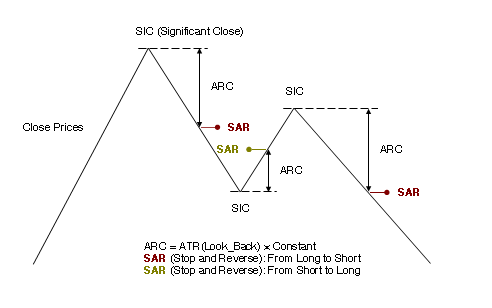R&D Blog
J. Welles Wilder, Jr. – Volatility Breakout | Trading Strategy (Entry)
I. Trading Strategy
Developer: J. Welles Wilder, Jr. Concept: Trend-following based on volatility breakouts. Source: Wilder, J. W. (1978). New Concepts in Technical Trading Systems. Greensboro: Trend Research. Research Goal: Performance verification of the 2-phase reversal model (long/short). Specification: Table 1. Results: Figure 1-2. Portfolio: 42 futures markets from four major market sectors (commodities, currencies, interest rates, and equity indexes). Data: 33 years since 1980. Testing Platform: MATLAB®.
II. Sensitivity Test
All 3-D charts are followed by 2-D contour charts for Profit Factor, Sharpe Ratio, Ulcer Performance Index, CAGR, Maximum Drawdown, Percent Profitable Trades, and Avg. Win / Avg. Loss Ratio. The final picture shows sensitivity of Equity Curve.
Tested Variables: Constant & Look_Back (Definitions: Table 1):
Figure 1 | Portfolio Performance (Inputs: Table 1; Commission & Slippage: $0).
| STRATEGY | SPECIFICATION | PARAMETERS |
| Auxiliary Variables: | True_High[i] = max(High[i], Close[i − 1]) True_Low[i] = min(Low[i], Close[i − 1]) True_Range[i] = True_High[i] − True_Low[i] Average True Range (ATR): ATR[i] = average(True_Range[i] over the Look_Back period) ARC[i] = ATR[i] × Constant SIC: The Significant Close – The extreme favorable close price reached while in a trade. SAR: The Stop and Reverse point – A point defined by the ARC[i] distance from the SIC. Index: i ~ Current Bar. | Look_Back = [4, 80], Step = 2; Constant = [2.0, 20.0], Step = 0.5; |
| Setup: | N/A | |
| Filter: | N/A | |
| Entry: | Long Trades: A buy on the close is placed when the close is above the ARC distance point from the SIC (The Significant Close – The extreme favorable close price reached while in a trade). Short Trades: A sell on the close is placed when the close is below the ARC distance point from the SIC (The Significant Close – The extreme favorable close price reached while in a trade).  | |
| Exit: | Stop Loss Exit: ATR(ATR_Length) is the Average True Range over a period of ATR_Length. ATR_Stop is a multiple of ATR(ATR_Length). Long Trades: A sell stop is placed at [Entry − ATR(ATR_Length) * ATR_Stop]. Short Trades: A buy stop is placed at [Entry + ATR(ATR_Length) * ATR_Stop]. Reversal: The volatility breakout system is a true reversal system which means that the position is reversed at every entry signal. | ATR_Length = 20; ATR_Stop = 6; |
| Sensitivity Test: | Look_Back = [4, 80], Step = 2 Constant = [2.0, 20.0], Step = 0.5 | |
| Position Sizing: | Initial_Capital = $1,000,000 Fixed_Fractional = 1% Portfolio = 42 US Futures ATR_Stop = 6 (ATR ~ Average True Range) ATR_Length = 20 | |
| Data: | 42 futures markets; 33 years (1980/01/01−2013/09/30) |
Table 1 | Specification: Trading Strategy.
III. Sensitivity Test with Commission & Slippage
Tested Variables: Constant & Look_Back (Definitions: Table 1):
Figure 2 | Portfolio Performance (Inputs: Table 1; Commission & Slippage: $100 Round Turn).
IV. Rating: J. Welles Wilder, Jr. – Volatility Breakout | Trading Strategy
A/B/C/D
Related Entries: Dow Theory – Trend (Entry & Exit) | Bollinger Bands – Momentum Model (Setup) | Keltner Channels – 3-Phase Model (Setup) | Combined Donchian Channels (Entry & Exit) | Multiple Time Frames – Bruce Babcock (Entry)
Related Topics: (Public) Trading Strategies
CFTC RULE 4.41: HYPOTHETICAL OR SIMULATED PERFORMANCE RESULTS HAVE CERTAIN LIMITATIONS. UNLIKE AN ACTUAL PERFORMANCE RECORD, SIMULATED RESULTS DO NOT REPRESENT ACTUAL TRADING. ALSO, SINCE THE TRADES HAVE NOT BEEN EXECUTED, THE RESULTS MAY HAVE UNDER-OR-OVER COMPENSATED FOR THE IMPACT, IF ANY, OF CERTAIN MARKET FACTORS, SUCH AS LACK OF LIQUIDITY. SIMULATED TRADING PROGRAMS IN GENERAL ARE ALSO SUBJECT TO THE FACT THAT THEY ARE DESIGNED WITH THE BENEFIT OF HINDSIGHT. NO REPRESENTATION IS BEING MADE THAT ANY ACCOUNT WILL OR IS LIKELY TO ACHIEVE PROFIT OR LOSSES SIMILAR TO THOSE SHOWN.
RISK DISCLOSURE: U.S. GOVERNMENT REQUIRED DISCLAIMER | CFTC RULE 4.41
Codes: matlab/wilder/1/





























